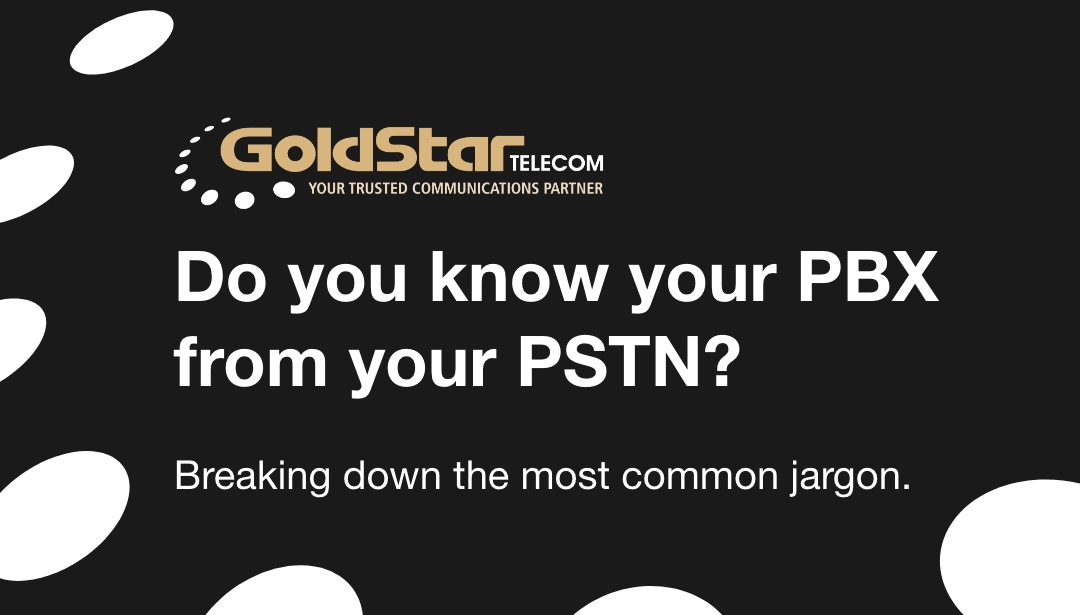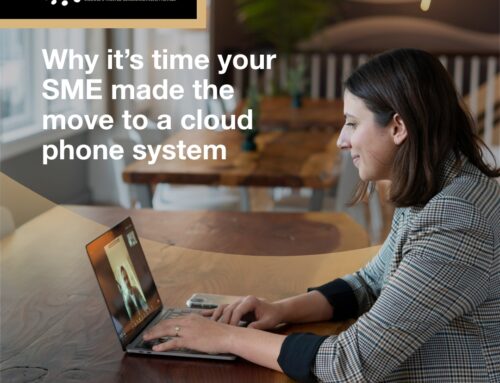If there’s one thing the tech world loves, it’s jargon. The business telecoms world is no exception, and is full of acronyms, initialisms, buzzwords and tech speak. But since that tech is so useful, it pays to understand the basic lingo.
This blog will help with exactly that. Here at GoldStar, we’ve been providing business phone systems in Ireland for over 35 years. And in that time, customers have often asked us to explain this or that term.
So these are our answers to some of the most frequently asked questions about business telecoms!
What is a PBX?
PBX stands for private branch exchange. Really it should be PBE then, but the letter X is irresistible to tech people! Essentially, a PBX is synonymous with a phone system – an enclosed telephone network within an organisation.
The technology has changed a lot since PBXs first appeared in the 1970s, but the principle is the same. In the contemporary telecoms industry, you’re more likely to hear the term “phone system” than “PBX”.
What’s an on-premise phone system?
With an on-premise phone system, the physical hardware needed to run it is stored on your premises – hence the name.
You generally pay for the hardware in full, and then it’s yours to store and maintain. This means you need space for the equipment, and capital for the upfront costs.
Although it’s less flexible than a cloud system (see below), many businesses in Ireland prefer this option. With an on-premise PBX, you can still route calls over the internet.
What’s a cloud phone system?
You’ll see a lot of names for this – cloud phone system, cloud PBX, hosted PBX … They all mean the same thing. These do everything an on-premise system does, but calls are hosted on an offsite data centre and routed through your existing internet connection.
Rather than big up-front capital expenditure, with cloud you pay a monthly fee for each user of the platform. This makes it more flexible, since you can add and remove licences very easily. You also don’t need to store any hardware apart from the handsets and other devices you use to make calls.
This also means you can use it from anywhere, which is great for more flexible working environments. It means those who work outside the office have full access.
What’s better – a cloud or on-premise phone system?
There’s no one-size-fits-all answer here. If you need flexibility, cloud is probably the answer as it’s much more rapidly scalable. But we’d recommend checking out our longer blog on the subject.
What is VoIP?
VoIP stands for voice over internet protocol. Essentially what that means is that you’re routing calls (voice) over the internet (IP), instead of the traditional ISDN network.
There are lots of benefits to VoIP. For one, calls are often cheaper. In addition, you’re futureproof. The existing ISDN network is a 20th century technology. In Ireland as in other countries, it’s gradually being phased out to make way for an IP infrastructure. With VoIP, you’re ahead of that change.
What are unified communications?
Unified communications, or UC, essentially means placing all business communication channels in a single platform. This means you can do voice calls, videoconferencing, instant messaging and email from the same application.
At GoldStar, we offer Ericsson-LG’s iPECS ONE, an industry-leading UC app. It includes time-saving features like presence, which shows in real time who’s available and who isn’t. It’s also incredibly flexible. It’s a downloadable app you can use on a mobile, tablet, laptop or desktop.
This essentially means you can have the full power of a phone system on any device, anywhere, making remote work much more effective. You can even run it on a desktop browser, with no downloads required at all.
What’s an IVR?
IVR stands for interactive voice response. You can think of it as a virtual receptionist. Callers phone in, and interact with recorded messages to get through to the right place. This could be via speech recognition, or just keying in numbers (“press 1 to speak to a receptionist”).
What are hunt groups?
In telecoms, a hunt group is a defined set of people with particular specialisms, who calls are routed to by your IVR. You’d normally set up hunt groups for different departments. Combined with your IVR, this automates call routing, which is much more efficient than routing calls manually via a receptionist.
Do I need call recording?
If you make and take a high volume of calls, call recording is pretty much essential. The first reason is quality assurance. If you run a contact centre, you need to be able to sample calls in order to maintain standards. You can also use successful calls for training purposes.
It’s also good for complaint resolution. If a customer is unhappy about something, you need to be able to investigate properly. Having a record of their calls allows for swifter, and more transparent resolution of grievances.
Our call recording app has advanced features to make the whole process much easier. You can sample calls at random for quality assurance. And if you’re looking for a specific call, you can search by multiple fields, including date, phone number, customer, department and agent. It’s cloud-hosted, which means you can listen from anywhere, and fully GDPR-compliant.
What is call analytics?
Call analytics apps will automatically analyse call KPIs, allowing you to manage resources as efficiently as possible. For instance, if you get spikes at a particular time, you can look to increase numbers to meet the demand. A call analytics app will make this sort of information more digestible.
We can offer an advanced analytics app that’s user-friendly and offers rich insights. You can arrange for it to send custom reports automatically, at intervals of your choosing. In addition, it allows you to “wallboard” real-time data. This allows you to understand both long- and short-term trends, allowing you to manage calls with maximum efficiency.
What is PSTN?
PSTN stands for public switched telephone network. This is the copper-wire network that began it all in the late 19th century. Although there are still PSTN lines in Ireland, they are being phased out.
What is ISDN?
Short for integrated services digital network, this is the late 20th century upgrade to PSTN. As the name suggests, it’s a digital network, capable of managing more traffic. But more and more countries are retiring their ISDN infrastructure to make way for a fully IP-based network.
What’s a SIP trunk?
SIP stands for session initiation protocol. You can think of it as a way of routing calls over the internet, instead of traditional ISDN lines. For more information, check out the SIP section of our website.
Want to learn more?
We hope this info is helpful. Telecoms is technical, but the principles behind it are pretty straightforward. Communication is fundamental in business, and the goal is to make it as efficient as possible.
Here at GoldStar, we know how to help businesses achieve that goal. We’ve been in telecoms for over 35 years, and we’re Ireland’s only distributor of Ericsson-LG’s industry-leading iPECS range of products. This means we’re uniquely positioned to advise business on what will work best for them.
We pride ourselves on our knowledge, service and impartial advice. We’re happy to demystify any telecoms jargon you don’t understand, and determined to make sure your communication is as productive as possible. Get in touch to find out more.





Leave A Comment